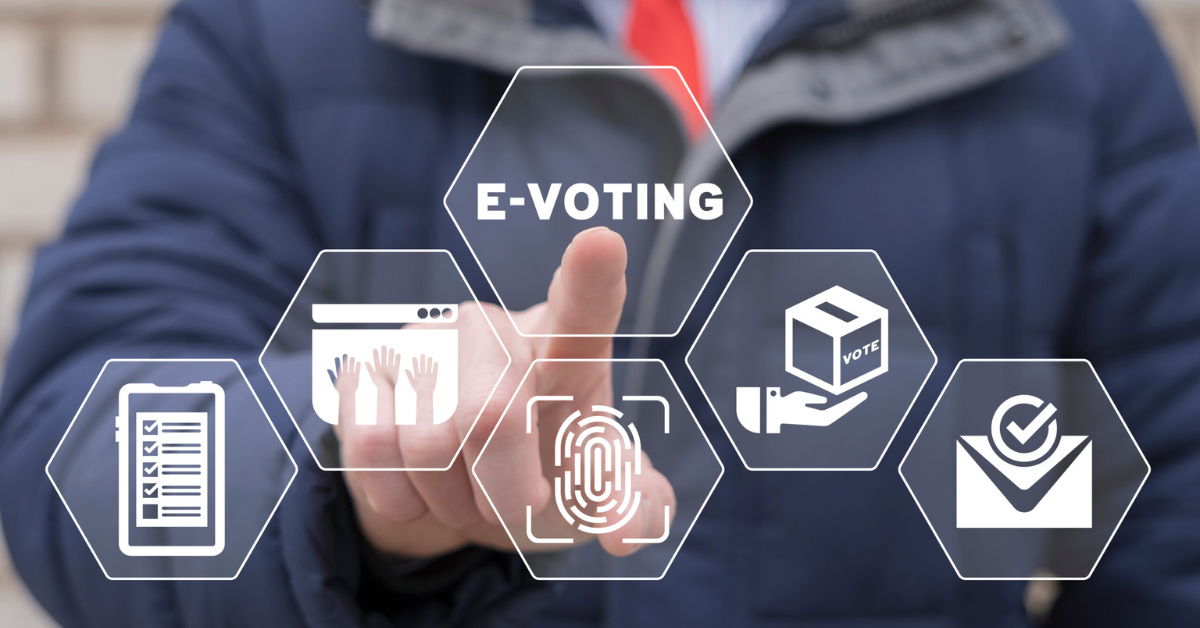The world is rapidly transitioning towards digital solutions, and electoral systems are no exception. E-voting (electronic voting) has emerged as a modern alternative to traditional paper-based voting, offering efficiency, accessibility, and faster results. Countries like Estonia, Switzerland, and India have experimented with electronic voting to streamline the democratic process.
However, the adoption of e-voting raises several legal, security, and ethical concerns that challenge the integrity of democratic elections. Cybersecurity threats, voter verification issues, and the risk of hacking have sparked debates on whether e-voting can truly replace conventional voting methods.
This blog explores the concept of e-voting, its benefits, legal concerns, global examples, and the challenges it faces in digital democracy.
What is E-Voting?
E-voting refers to casting and counting votes electronically, either through:
- Electronic Voting Machines (EVMs) – Used at polling stations, where voters select their choice on a digital screen.
- Internet-Based Voting (i-Voting) – Allows voters to cast their votes remotely via a secure online platform.
- Blockchain Voting – Uses decentralized ledger technology to enhance transparency and security.
E-voting can improve voter turnout and reduce election costs, but its effectiveness depends on robust legal and technological frameworks.
Advantages of E-Voting in Digital Democracy
1. Speed and Accuracy
- Electronic voting speeds up vote counting, reducing human errors in tallying.
- Election results can be announced quickly, improving administrative efficiency.
2. Accessibility for All
- Enables people with disabilities, senior citizens, and overseas voters to participate in elections easily.
- Remote e-voting eliminates the need to visit physical polling booths.
3. Transparency and Auditability
- Blockchain-based e-voting systems can offer tamper-proof records, enhancing trust in election results.
- Digital records can be easily audited to verify the authenticity of votes.
4. Cost Reduction
- Eliminates expenses related to paper ballots, printing, and logistics.
- Reduces administrative burden and resources required for elections.
5. Environmental Benefits
- Paperless voting reduces the environmental impact of elections.
Despite these advantages, legal and security concerns remain a significant challenge.
Legal Challenges in E-Voting
The implementation of e-voting must comply with constitutional and electoral laws to maintain fairness and transparency. Key legal challenges include:
1. Voter Privacy and Secrecy of Ballot
- The right to a secret ballot is a fundamental principle of democracy.
- E-voting systems must ensure that votes remain confidential and cannot be traced back to individuals.
2. Cybersecurity Threats
- Online voting systems are vulnerable to hacking, malware, and cyberattacks.
- Foreign interference and vote manipulation could undermine election credibility.
3. Legal Framework for Dispute Resolution
- What happens if a voter claims their electronic vote was altered?
- Legal provisions must clarify how disputes will be addressed in case of technical failures or cyber breaches.
4. Digital Divide and Accessibility Issues
- Not all citizens have access to the internet or digital devices.
- E-voting could exclude marginalized communities lacking technological resources.
5. Trust in the System
- Unlike physical ballots, electronic votes cannot be manually recounted.
- Legal mechanisms must ensure voters trust the system’s fairness and security.
6. International Human Rights and Compliance
- United Nations and global electoral guidelines stress free and fair elections.
- Countries implementing e-voting must ensure compliance with international voting standards.
E-Voting Around the World: Successes and Challenges
1. Estonia – A Pioneer in Internet Voting
Estonia has been a global leader in i-Voting, allowing citizens to vote online using secure digital IDs since 2005.
✅ Success: High voter turnout, secure encryption, and strong cybersecurity measures.
❌ Challenge: Concerns about hacking risks and voter fraud.
2. United States – Limited Use and Security Concerns
Some U.S. states allow electronic ballot marking systems, but internet voting is restricted due to hacking fears.
✅ Success: Secure EVM-based voting has improved election management.
❌ Challenge: Russian interference allegations in the 2016 elections raised concerns over electronic vote security.
3. India – EVMs and the Voter Verified Paper Audit Trail (VVPAT)
India has used EVMs since 2000, reducing election fraud and manual counting errors.
✅ Success: EVMs make vote counting faster and reduce fake voting.
❌ Challenge: Political parties have alleged hacking risks and demanded VVPAT paper slips for verification.
4. Switzerland – Blockchain-Based Voting Trials
Switzerland has experimented with blockchain-powered e-voting to ensure transparent elections.
✅ Success: Improved trust through decentralized voting.
❌ Challenge: Ensuring data privacy while maintaining transparency.
Solutions to E-Voting Challenges
To overcome legal and security challenges, governments must focus on:
1. Strong Cybersecurity Measures
- End-to-end encryption and multi-factor authentication for online voting.
- Regular cybersecurity audits to detect and prevent hacking threats.
2. Voter Verification and Authentication
- Biometric authentication or unique digital IDs to prevent voter fraud.
- Secure, tamper-proof blockchain solutions for vote transparency.
3. Legal Reforms and Electoral Laws
- Amendments in Representation of the People Act (in India) to regulate e-voting.
- Legal mechanisms for voters to challenge fraudulent or incorrect vote counts.
4. Digital Literacy and Awareness
- Government campaigns to educate citizens about safe and secure online voting.
- Ensuring that technologically disadvantaged groups are not excluded.
5. Transparent Testing and Auditing
- Independent third-party audits before deploying e-voting on a large scale.
- Paper-trail systems like VVPATs (Voter Verified Paper Audit Trails) to verify electronic votes.
Future of E-Voting in Digital Democracy
E-voting is an inevitable evolution of electoral processes, but building a legally sound and technologically secure system is crucial. Future trends include:
🔹 Blockchain-based elections for secure and transparent voting.
🔹 AI-driven fraud detection to prevent vote manipulation.
🔹 Biometric and facial recognition authentication for foolproof voter verification.
🔹 Hybrid voting models combining traditional ballots with digital voting options.
While digital democracy has the potential to enhance electoral participation, governments must balance innovation with legal safeguards to ensure fair, transparent, and credible elections.
Conclusion
E-voting represents a significant shift in electoral processes, offering speed, efficiency, and accessibility. However, its implementation requires strong legal frameworks, cybersecurity protections, and public trust to ensure free and fair elections.
As digital democracy evolves, governments must address privacy concerns, legal challenges, and cyber threats before widespread adoption. With the right safeguards in place, e-voting can revolutionize the democratic process, making elections more inclusive, secure, and efficient.

